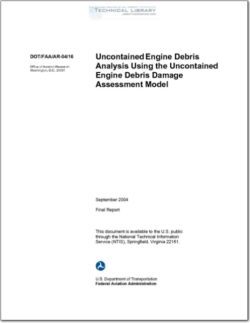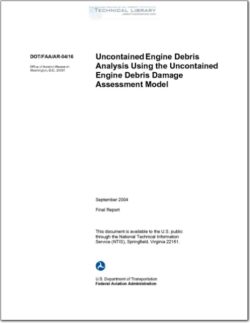DOT-FAA-AR-04-16

- Version
- 227 Downloads
- 2.38 MB File Size
- 1 File Count
- March 23, 2016 Create Date
- March 23, 2016 Last Updated
Uncontained Engine Debris Analysis Using the Uncontained Engine Debris Damage Assessment Model

As part of the Federal Aviation Administration Aircraft Catastrophic Failure Prevention
Program, the Naval Air Warfare Center was tasked to examine and evaluate the Uncontained
Engine Debris Damage Assessment Model (UEDDAM). UEDDAM was written to provide a
standardized tool for uncontained engine rotor failure analysis. This study was conducted to
exercise the code and evaluate its usefulness in performing rotor burst analysis on a small
generic business jet and a generic twin-engine aircraft. This evaluation also supported the
Aviation Rulemaking Advisory Committee, Power Plant Installation Harmonization Working
Group activities.
This report explains the analysis methodology, results, and trade studies performed using
UEDDAM. Though the aircraft used in the study do not represent a specific aircraft, industry
input was used to create the input data required so that the results would be comparable to a real
aircraft analysis.
Although the condition of aircraft engine rotors are regularly monitored, uncontained disk burst
events still occur worldwide. Uncontained rotor failures can be caused by various reasons
including fatigue and internal and external foreign object debris.
Under the Federal Aviation Administration (FAA) Aircraft Catastrophic Failure Prevention
Program, the Naval Air Warfare Center, Weapons Division (Systems Vulnerability Branch/Code
418300D) at China Lake, CA, (NAWC-WD) has developed an analysis tool to evaluate the
probability of hazard to an aircraft given engine rotor failure. To address this tasking, NAWC-
WD has teamed with SURVICE Engineering to develop a computer program called the
Uncontained Engine Debris Damage Assessment Model (UEDDAM). The model is intended to
aid the design and certification of aircraft, providing a standardized tool (methodology) to
conduct rotor burst assessments. As part of that effort, a generic business jet (GBJ) and a
generic twin-engine aircraft (GT) were evaluated for engine rotor burst using UEDDAM. These
studies were intended to refine the analysis process and examine the capabilities of UEDDAM.
| File | Action |
|---|---|
| DOT-FAA-AR-04-16 Uncontained Engine Debris Analysis Using the Uncontained Engine Debris Damage Assessment Model.pdf | Download |

Comment On This Post